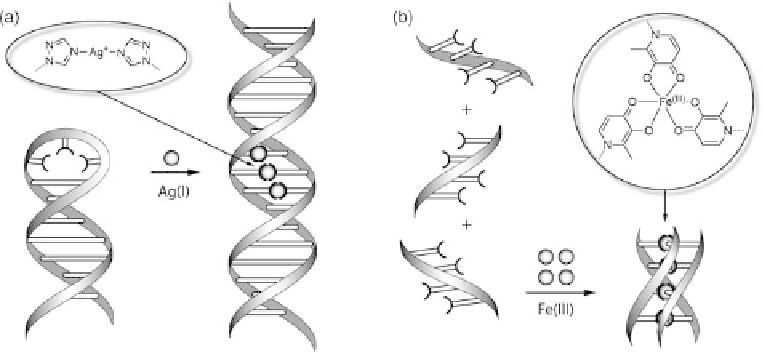Chemistry Reference
In-Depth Information
9.6 Functions, Applications and Future Directions
9.6.1 Duplex Stabilization and Conformational Switching
The first two decades of research on metal base pairing mainly focused on the develop-
ment and characterization of new metal-mediated base pairing systems in order to eluci-
date the critical parameters and scope of metal complexation. Since a number of systems
have been proven robust and reliable in the context of various sequences, current research
efforts are shifting towards the application of metal base pairs in fields such as nano-
technology and medical diagnostics.
The increase in duplex stabilization by metal base pairing has been applied to the
stabilization of short double strands, as explained in Section 9.4.3. The process
depicted in Figure 9.18a goes even further: a palindromic single-strand containing a
central stretch of three 1,2,4-triazole ligands forms a hairpin structure in the absence
of Ag(I) ions [42]. The addition of Ag(I) to the sample results in a structural conver-
sion into a double-stranded helix containing three consecutive Ag(I)-mediated base
pairs. Such a metal-triggered conformational change might find use in future DNA-
based nanomechanical devices. Even more intriguing is the reaction shown in
Figure 9.18b: a tetrameric oligonucleotide consisting of hydroxypyridone ligands was
found to form triple helical, tetranuclear complexes upon addition of Fe(III) since the
Fe(III) ions strictly demand a six-coordinate environment [55]. Keeping it in mind that
hydroxypyridone-containing strands form double strands with Cu(II) as the coordi-
nated metal, a structural conversion between double-stranded and triple-stranded con-
structs upon a change of metal ion is imaginable.
Figure 9.18 Examples of structural transitions triggered by the addition of metal ions to
ligand-containing DNA sequences. (a) Hairpin-duplex transformation upon binding of Ag(I).
(b) Formation of triple helices by incorporation of hexacoordinate Fe(III) into hydroxypyri-
done-containing sequences that otherwise give a double-stranded DNA with Cu(II).

Search WWH ::

Custom Search